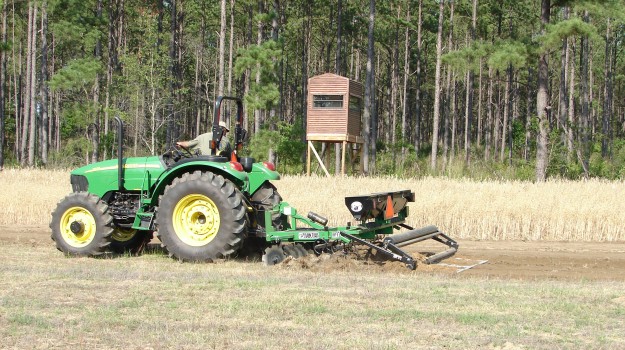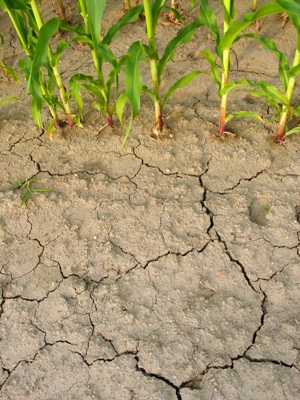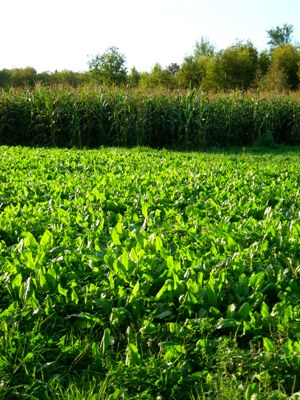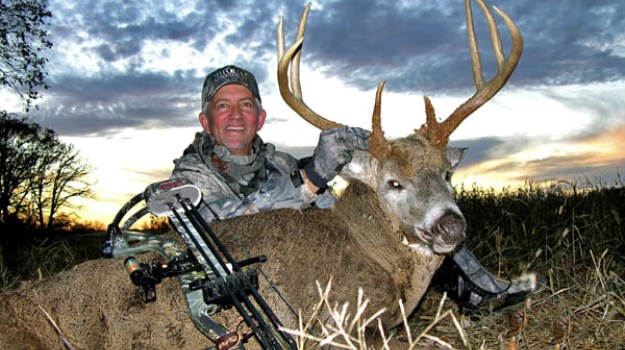
By Blaine Burley
No matter what size property you manage, if you want to consistently grow trophy-class bucks on your property, you must provide quality, year-round nutrition to your deer herd. In most cases, food plots (when properly managed) can be the most cost-effective means of providing this year-round nutrition. Even though deer hunting season is over, don’t forget about your deer during the spring, summer and then again during the winter months. Late winter through late summer is the time of year when bucks are growing their antlers and does are feeding their fawns. This is when your deer herd needs nutrition the most!
With today’s ever-changing climates and rainfall often in short supply, it is very important for land managers to be prepared for the worst. Certain steps can be taken during the hot, dry summer months to effectively maximize the production of your food plots even during drought conditions or periods of limited rainfall. Inadequate precipitation or droughts (especially during the summer months) can be detrimental to your food plots if you are not prepared. Proper soil preparation, planting methods, site and seed selection are the keys to providing year-round forage production during these dry periods. Sufficient moisture is the number one key determinant for success when planting anything for whitetails.
Plot preparation is one of the first steps in conserving and maximizing your rainfall and soil moisture. For example, it is of the utmost importance to have your soils deep-tilled well in advance of your warm-season plantings. In most cases, you can effectively deep-till your plots with a chisel plow, moldboard plow and/or subsoiler. As a “deer farmer,” depending on your soil types, you may need one or more of these implements to effectively break up your soils to maximize your soil moisture. Warm-season food plots should be deep-tilled in the early fall to allow the plots to rest and bank moisture for the upcoming spring/summer plantings. If rain comes during the fall/winter it will be captured in the soil. You want your plots to act as “sponges” this time of year in order to collect rainfall for the upcoming spring/summer months. It is also very important to not allow the encroachment of unwanted plants (grass, weeds, etc) in the food plots during this resting/rainfall collection period because these invaders will steal the moisture and nutrients you are trying to save.
During the fall and winter months there is less moisture evaporation thus allowing more moisture retention for longer in the soil due to the cooler days and temperatures. Consequently, when spring time arrives there will be moisture available to help get your plants up and growing so the root systems can establish and prepare the plants for the drier, warmer months ahead. Having a well-tilled bed also allows the roots to penetrate deeper allowing them to better compete for available moisture and nutrients. Using the same disk-harrow year after year without running a deeper chisel plow, moldboard and/or subsoiler through your plots can often result in a hardpan base relatively close to the surface. Also, deer hooves are some of the best compactors in the world and will compact your soils as they feed. This can lead to more competition among plants, less moisture retention, and shallower roots. I highly recommend that you deep-till your plots every 2-3 years.
 Soil compaction can also lead to other problems. Sometimes a hard rain (especially on heavy, clay soils) can compact the soil and leave a hard, crusty layer on top. This firm layer increases rain run-off on your plots so less moisture is being absorbed into the soils. In this case, it is best to lightly disk and/or run a plow through your food plots to break the hard crust and allow your food plots gather more moisture. Whenever you prepare and plant your food plots it is best to minimize the number of trips through to reduce soil compaction and better retain moisture. I recommend that you use a multi-use implement (such as a field cultivator or a PLOTMASTER™) that performs several functions at the same time to limit soil compaction whenever possible.
Soil compaction can also lead to other problems. Sometimes a hard rain (especially on heavy, clay soils) can compact the soil and leave a hard, crusty layer on top. This firm layer increases rain run-off on your plots so less moisture is being absorbed into the soils. In this case, it is best to lightly disk and/or run a plow through your food plots to break the hard crust and allow your food plots gather more moisture. Whenever you prepare and plant your food plots it is best to minimize the number of trips through to reduce soil compaction and better retain moisture. I recommend that you use a multi-use implement (such as a field cultivator or a PLOTMASTER™) that performs several functions at the same time to limit soil compaction whenever possible.
Proper plot size is also very important when it comes to growing productive warm-season food plots. If you don’t have large enough warm-season plots, deer can easily over-graze your plots and limit forage production. Larger plots are easier to maintain and more productive than smaller plots. You must also have enough plots on your property to effectively feed the number of deer that will be utilizing them.
As a general rule, one-acre of year-round food plots will support approximately four (4) adult deer. Therefore, if you have 100 deer on your property, you will need approximately 25 acres of year-round food plots on your property depending on quality of native habitat and other quality food sources (crops, etc) available to your local deer herd. It is also important that you choose a fertile site with plenty of sunlight for optimum photosynthesis and production for your warm-season plots.
Knowing what and when to plant can be just as important as the other steps above. For example, I don’t recommend double cropping your plots in drought-prone areas. Planting winter and summer food plots on separate sites is a very effective technique when it comes to drought-proofing your plots. This method of water conservation allows plants to have more moisture readily available even during dry times. Depending on the amount of tillable acres available, it is often best to plant a portion of the field in the summer (warm-season plot) and the rest in the winter (cool-season plot) or have entirely separate plots.
For planning purposes, it is imperative that you select the correct plant types in order to supply enough nutrition to feed your deer throughout the entire year. For this to happen, you should select seed blends that are designed for forage production (not seed production) and they must be able to survive the stressful dry periods while still providing adequate tonnage and nutrition. Annuals seem to work better than perennials in low rainfall areas. Because of their desirable characteristics some managers elect to use deep-rooted perennial plants such as clovers, chicory, and alfalfa knowing that they will only get one growing season out of them when moisture is lacking, treating the perennial like a bi-annual. It will provide forage for the fall, go into dormancy, come back the following spring and then die off in the dry summer months.
 Warm season plantings such as LabLab and forage-type soybeans do a great job in dry climates if you properly prepare your plots. These deep-rooted plants produce good tonnage even during very dry periods. Too often, people plant seed-producing plants which are made to produce seed (first and fore-most) and then die. This slows down and dramatically reduces the leaf (forage) production. This makes plants like LabLab and forage-type soybeans more favorable to plant especially in areas with long growing seasons because they are designed to produce maximum forage (leaf matter) not seed. These plants will also last longer into the growing season (often well into the hunting season in many parts of the country) and will attract deer for great early season hunting.
Warm season plantings such as LabLab and forage-type soybeans do a great job in dry climates if you properly prepare your plots. These deep-rooted plants produce good tonnage even during very dry periods. Too often, people plant seed-producing plants which are made to produce seed (first and fore-most) and then die. This slows down and dramatically reduces the leaf (forage) production. This makes plants like LabLab and forage-type soybeans more favorable to plant especially in areas with long growing seasons because they are designed to produce maximum forage (leaf matter) not seed. These plants will also last longer into the growing season (often well into the hunting season in many parts of the country) and will attract deer for great early season hunting.
Whereas cool-season plots should be planted when temperatures start to drop during the late fall, warm-season plots need to be planted after the last frost and when soil temperatures start to rise above 65 degrees. When warm-season plants like LabLab and forage-type soybeans are planted, it is very important that you use the correct planting rates in order to keep your plants spaced out to minimize competition for available moisture and nutrients. Therefore, it is best to drill your seed with a conventional grain drill or a row-planter in low rainfall areas. This allows seeds to be pressed into the ready moisture and have them planted at a precise rate.
Over-seeding in low rainfall areas is not recommended. This will cause plants to die off sooner especially if limited moisture is available. Also, if plants are planted in rows, they can be sprayed and/or cultivated (to remove unwanted plants and weeds). Often you can cultivate LabLab and/or soybeans several times before the plants become too big. Fall plantings are a bit more forgiving and often you can get away with broadcast seeding since more moisture is available in the fall and less moisture is lost to evaporation.
You can also drought-proof your plants by applying DeltaAg’s Seed Coat to your seeds just prior to planting. This unique product actually treats the soil adjacent to the seed and helps the plant roots to form micorrhizal fungi which help them to absorb more moisture and nutrients faster. A larger and better root system becomes more critical in dry conditions and helps to improve the drought-tolerance of your plants.
Both pre and post-emergent herbicides can be used to minimize the impact of unwanted invading plants that can rob moisture and nutrients from the plants that you are trying to grow. Legumes like LabLab, clovers, and alfalfa can be readily treated with pre and post-emergent herbicides to help minimize unwanted weed competition. Mixing grasses, legumes and/or forbs such as chicory make it more difficult to find herbicides that will work without harming at least one of the species that you are trying to grow.
In order to provide enough forage (especially when planting at lower planting rates) and keep weed competition down, you must keep your deer from over-grazing your plots until they are established. This time frame can vary depending on your deer density, soil type, nutrients, moisture, and other climate factors. Typically, it is best to keep deer off your warm-season plots for 3-6 weeks to allow root systems to become established and the rows to fill in making it harder for weeds to become established. In most cases, you can keep your deer off your plots through the use of temporary fences, electric fences or Biologic’s P2 Plot Protection System.
It is not impossible to grow plants in drought-prone areas and/or areas of low rainfall. Putting all the pieces of the puzzle together will allow your plants a better chance of surviving dry conditions, thus feeding your deer when they need it the most. However, you MUST do it RIGHT if you want results! Taking short cuts often results in poor plant production and/or total crop failure. Your overall plot production will significantly increase with proper preparation and planning, some of which must take place well in advance of your actual planting.
Photo credit: Dry ground by Jan Matoška | Dreamstime.com






























